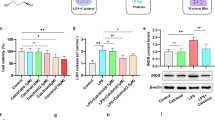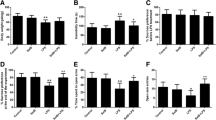Abstract
Neuroinflammation has emerged as a crucial factor in the development of depression. Despite the well-known anti-inflammatory properties of 6-gingerol, its potential impact on depression remains poorly understood. This study aimed to investigate the antidepressant effects of 6-gingerol by suppressing microglial activation. In vivo experiments were conducted to evaluate the effect of 6-gingerol on lipopolysaccharide (LPS)-induced behavioral changes and neuroinflammation in rat models. In vitro studies were performed to examine the neuroprotective properties of 6-gingerol against LPS-induced microglial activation. Furthermore, a co-culture system of microglia and neurons was established to assess the influence of 6-gingerol on the expression of synaptic-related proteins, namely synaptophysin (SYP) and postsynaptic density protein 95 (PSD95), which are influenced by microglial activation. In the in vivo experiments, administration of 6-gingerol effectively alleviated LPS-induced depressive behavior in rats. Moreover, it markedly suppressed the activation of rat prefrontal cortex (PFC) microglia induced by LPS and the activation of the NF-κB/NLRP3 inflammatory pathway, while also reducing the levels of inflammatory cytokines IL-1β and IL-18. In the in vitro experiments, 6-gingerol mitigated nuclear translocation of NF-κB p65, NLRP3 activation, and maturation of IL-1β and IL-18, all of which were induced by LPS. Furthermore, in the co-culture system of microglia and neurons, 6-gingerol effectively restored the decreased expression of SYP and PSD95. The findings of this study demonstrate the neuroprotective effects of 6-gingerol in the context of LPS-induced depression-like behavior. These effects are attributed to the inhibition of microglial hyperactivation through the suppression of the NF-κB/NLRP3 inflammatory pathway.
Graphical Abstract









Similar content being viewed by others
Data Availability
No datasets were generated or analysed during the current study.
References
Abdallah CG, Sanacora G, Duman RS, Krystal JH (2015) Ketamine and rapid-acting antidepressants: a window into a new neurobiology for mood disorder therapeutics. Annu Rev Med 66:509–523. https://doi.org/10.1146/annurev-med-053013-062946
Bachiller S, Jiménez-Ferrer I, Paulus A, Yang Y, Swanberg M, Deierborg T, Boza-Serrano A (2018) Microglia in Neurological diseases: a Road Map to Brain-Disease Dependent-Inflammatory response. Front Cell Neurosci 12:488. https://doi.org/10.3389/fncel.2018.00488
Borgonetti V, Governa P, Biagi M, Pellati F, Galeotti N (2020) Zingiber officinale Roscoe Rhizome extract alleviates neuropathic pain by inhibiting neuroinflammation in mice. Phytomedicine 78:153307. https://doi.org/10.1016/j.phymed.2020.153307
Choi AJ, Ryter SW (2014) Inflammasomes: molecular regulation and implications for metabolic and cognitive diseases. Mol Cells 37:441–448. https://doi.org/10.14348/molcells.2014.0104
Coley AA, Gao WJ (2018) PSD95: a synaptic protein implicated in schizophrenia or autism? Prog Neuropsychopharmacol Biol Psychiatry 82:187–194. https://doi.org/10.1016/j.pnpbp.2017.11.016
Dang R, Zhou X, Tang M, Xu P, Gong X, Liu Y, Jiao H, Jiang P (2018) Fish oil supplementation attenuates neuroinflammation and alleviates depressive-like behavior in rats submitted to repeated lipopolysaccharide. Eur J Nutr 57:893–906. https://doi.org/10.1007/s00394-016-1373-z
Drevets WC, Price JL, Furey ML (2008) Brain structural and functional abnormalities in mood disorders: implications for neurocircuitry models of depression. Brain Struct Funct 213:93–118. https://doi.org/10.1007/s00429-008-0189-x
Duman RS, Aghajanian GK (2012) Synaptic dysfunction in depression: potential therapeutic targets. Science 338:68–72. https://doi.org/10.1126/science.1222939
Duman RS, Aghajanian GK, Sanacora G, Krystal JH (2016) Synaptic plasticity and depression: new insights from stress and rapid-acting antidepressants. Nat Med 22:238–249. https://doi.org/10.1038/nm.4050
Fang Y, Wan C, Wen Y, Wu Z, Pan J, Zhong M, Zhong N (2021) Autism-associated synaptic vesicle transcripts are differentially expressed in maternal plasma exosomes of physiopathologic pregnancies. J Transl Med 19:154. https://doi.org/10.1186/s12967-021-02821-6
Ge F, Yang H, Lu W, Shi H, Chen Q, Luo Y, Liu L, Yan J (2020) Ovariectomy induces microglial cell activation and inflammatory response in Rat Prefrontal cortices to accelerate the chronic unpredictable stress-mediated anxiety and depression. Biomed Res Int 2020(3609758). https://doi.org/10.1155/2020/3609758
Gravina G, Svedin P, Ardalan M, Levy O, Ek CJ, Mallard C, Lai JCY (2020) Staphylococcus epidermidis sensitizes Perinatal Hypoxic-Ischemic Brain Injury in male but not female mice. Front Immunol 11:516. https://doi.org/10.3389/fimmu.2020.00516
Han JJ, Li X, Ye ZQ, Lu XY, Yang T, Tian J, Wang YQ, Zhu L, Wang ZZ, Zhang Y (2019) Treatment with 6-Gingerol regulates dendritic cell activity and ameliorates the severity of experimental autoimmune encephalomyelitis. Mol Nutr Food Res 63:e1801356. https://doi.org/10.1002/mnfr.201801356
Han X, Liu P, Liu M, Wei Z, Fan S, Wang X, Sun S, Chu L (2020) [6]-Gingerol ameliorates ISO-Induced Myocardial Fibrosis by reducing oxidative stress, inflammation, and apoptosis through inhibition of TLR4/MAPKs/NF-κB pathway. Mol Nutr Food Res 64:e2000003. https://doi.org/10.1002/mnfr.202000003
Haneklaus M, O’Neill LA, Coll RC (2013) Modulatory mechanisms controlling the NLRP3 inflammasome in inflammation: recent developments. Curr Opin Immunol 25:40–45. https://doi.org/10.1016/j.coi.2012.12.004
Hu P, Wang D, Zhang Y, Cai Z, Ye T, Tong L, Xu X, Lu J, Liu F, Lu X, Huang C (2020) Apoptosis-triggered decline in hippocampal microglia mediates adolescent intermittent alcohol exposure-induced depression-like behaviors in mice. Neuropharmacology 170:108054. https://doi.org/10.1016/j.neuropharm.2020.108054
Iwata M, Ota KT, Duman RS (2013) The inflammasome: pathways linking psychological stress, depression, and systemic illnesses. Brain Behav Immun 31:105–114. https://doi.org/10.1016/j.bbi.2012.12.008
Iwata M, Ota KT, Li XY, Sakaue F, Li N, Dutheil S, Banasr M, Duric V, Yamanashi T, Kaneko K, Rasmussen K, Glasebrook A, Koester A, Song D, Jones KA, Zorn S, Smagin G, Duman RS (2016) Psychological Stress Activates the Inflammasome via Release of Adenosine Triphosphate and Stimulation of the Purinergic Type 2X7 Receptor. Biol Psychiatry 80:12–22. https://doi.org/10.1016/j.biopsych.2015.11.026
Jiang P, Guo Y, Dang R, Yang M, Liao D, Li H, Sun Z, Feng Q, Xu P (2017) Salvianolic acid B protects against lipopolysaccharide-induced behavioral deficits and neuroinflammatory response: involvement of autophagy and NLRP3 inflammasome. J Neuroinflammation 14:239. https://doi.org/10.1186/s12974-017-1013-4
Johnston KM, Powell LC, Anderson IM, Szabo S, Cline S (2019) The burden of treatment-resistant depression: a systematic review of the economic and quality of life literature. J Affect Disord 242:195–210. https://doi.org/10.1016/j.jad.2018.06.045
Kang HJ, Voleti B, Hajszan T, Rajkowska G, Stockmeier CA, Licznerski P, Lepack A, Majik MS, Jeong LS, Banasr M, Son H, Duman RS (2012) Decreased expression of synapse-related genes and loss of synapses in major depressive disorder. Nat Med 18:1413–1417. https://doi.org/10.1038/nm.2886
Kim CY, Seo Y, Lee C, Park GH, Jang JH (2018) Neuroprotective Effect and Molecular Mechanism of [6]-Gingerol against Scopolamine-Induced Amnesia in C57BL/6 Mice. Evid Based Complement Alternat Med, 2018, 8941564. https://doi.org/10.1155/2018/8941564
König H, König HH, Konnopka A (2019) The excess costs of depression: a systematic review and meta-analysis. Epidemiol Psychiatr Sci 29:e30. https://doi.org/10.1017/s2045796019000180
Konnopka A, König H (2020) Economic burden of anxiety disorders: a systematic review and Meta-analysis. PharmacoEconomics 38:25–37. https://doi.org/10.1007/s40273-019-00849-7
Kreisel T, Frank MG, Licht T, Reshef R, Ben-Menachem-Zidon O, Baratta MV, Maier SF, Yirmiya R (2014) Dynamic microglial alterations underlie stress-induced depressive-like behavior and suppressed neurogenesis. Mol Psychiatry 19:699–709. https://doi.org/10.1038/mp.2013.155
Lemprière S (2020) NLRP3 inflammasome activity as biomarker for primary progressive multiple sclerosis. Nat Rev Neurol 16:350. https://doi.org/10.1038/s41582-020-0366-y
Li Y, Xu B, Xu M, Chen D, Xiong Y, Lian M, Sun Y, Tang Z, Wang L, Jiang C, Lin Y (2017) 6-Gingerol protects intestinal barrier from ischemia/reperfusion-induced damage via inhibition of p38 MAPK to NF-κB signalling. Pharmacol Res 119:137–148. https://doi.org/10.1016/j.phrs.2017.01.026
Lim GY, Tam WW, Lu Y, Ho CS, Zhang MW, Ho RC (2022) Author correction: prevalence of Depression in the community from 30 countries between 1994 and 2014. Sci Rep 12:14856. https://doi.org/10.1038/s41598-022-19021-x
Maes M, Leonard B, Fernandez A, Kubera M, Nowak G, Veerhuis R, Gardner A, Ruckoanich P, Geffard M, Altamura C, Galecki P, Berk M (2011) (Neuro)inflammation and neuroprogression as new pathways and drug targets in depression: from antioxidants to kinase inhibitors. Prog Neuropsychopharmacol Biol Psychiatry 35:659–663. https://doi.org/10.1016/j.pnpbp.2011.02.019
Nazarian-Samani Z, Sewell RDE, Rafieian-Kopaei M (2020) Inflammasome Signaling and other factors implicated in Atherosclerosis Development and Progression. Curr Pharm Des 26:2583–2590. https://doi.org/10.2174/1381612826666200504115045
Pan Y, Chen XY, Zhang QY, Kong LD (2014) Microglial NLRP3 inflammasome activation mediates IL-1β-related inflammation in prefrontal cortex of depressive rats. Brain Behav Immun 41:90–100. https://doi.org/10.1016/j.bbi.2014.04.007
Ślusarczyk J, Trojan E, Głombik K, Piotrowska A, Budziszewska B, Kubera M, Popiołek-Barczyk K, Lasoń W, Mika J, Basta-Kaim A (2018) Targeting the NLRP3 inflammasome-related pathways via Tianeptine Treatment-suppressed Microglia polarization to the M1 phenotype in Lipopolysaccharide-Stimulated cultures. Int J Mol Sci 19. https://doi.org/10.3390/ijms19071965
Smith BL, Schmeltzer SN, Packard BA, Sah R, Herman JP (2016) Divergent effects of repeated restraint versus chronic variable stress on prefrontal cortical immune status after LPS injection. Brain Behav Immun 57:263–270. https://doi.org/10.1016/j.bbi.2016.05.004
Sun XY, Li LJ, Dong QX, Zhu J, Huang YR, Hou SJ, Yu XL, Liu RT (2021) Rutin prevents tau pathology and neuroinflammation in a mouse model of Alzheimer’s disease. J Neuroinflammation 18:131. https://doi.org/10.1186/s12974-021-02182-3
Tang Q, Huang K, Liu J, Wu S, Shen D, Dai P, Li C (2019) Fine particulate matter from pig house induced immune response by activating TLR4/MAPK/NF-κB pathway and NLRP3 inflammasome in alveolar macrophages. Chemosphere 236:124373. https://doi.org/10.1016/j.chemosphere.2019.124373
Thériault RK, Perreault ML (2019) Hormonal regulation of circuit function: sex, systems and depression. Biol Sex Differ 10:12. https://doi.org/10.1186/s13293-019-0226-x
Wainberg ML, Scorza P, Shultz JM, Helpman L, Mootz JJ, Johnson KA, Neria Y, Bradford JE, Oquendo MA, Arbuckle MR (2017) Challenges and opportunities in Global Mental Health: a research-to-practice perspective. Curr Psychiatry Rep 19:28. https://doi.org/10.1007/s11920-017-0780-z
Wang S, Yuan YH, Chen NH, Wang HB (2019) The mechanisms of NLRP3 inflammasome/pyroptosis activation and their role in Parkinson’s disease. Int Immunopharmacol 67:458–464. https://doi.org/10.1016/j.intimp.2018.12.019
Wright-Jin EC, Gutmann DH (2019) Microglia as Dynamic Cellular mediators of Brain function. Trends Mol Med 25:967–979. https://doi.org/10.1016/j.molmed.2019.08.013
Wu Y, Dissing-Olesen L, MacVicar BA, Stevens B (2015) Microglia: dynamic mediators of Synapse Development and Plasticity. Trends Immunol 36:605–613. https://doi.org/10.1016/j.it.2015.08.008
Yirmiya R, Rimmerman N, Reshef R (2015) Depression as a microglial disease. Trends Neurosci 38:637–658. https://doi.org/10.1016/j.tins.2015.08.001
Young JJ, Bruno D, Pomara N (2014) A review of the relationship between proinflammatory cytokines and major depressive disorder. J Affect Disord 169:15–20. https://doi.org/10.1016/j.jad.2014.07.032
Zhang JQ, Wu XH, Feng Y, Xie XF, Fan YH, Yan S, Zhao QY, Peng C, You ZL (2016) Salvianolic acid B ameliorates depressive-like behaviors in chronic mild stress-treated mice: involvement of the neuroinflammatory pathway. Acta Pharmacol Sin 37:1141–1153. https://doi.org/10.1038/aps.2016.63
Zhao M, Yao Y, Du J, Kong L, Zhao T, Wu D, Man L, Zhou W (2021) 6-Gingerol alleviates neonatal hypoxic-ischemic cerebral and White Matter Injury and contributes to functional recovery. Front Pharmacol 12:707772. https://doi.org/10.3389/fphar.2021.707772
Zusso M, Lunardi V, Franceschini D, Pagetta A, Lo R, Stifani S, Frigo AC, Giusti P, Moro S (2019) Ciprofloxacin and levofloxacin attenuate microglia inflammatory response via TLR4/NF-kB pathway. J Neuroinflammation 16:148. https://doi.org/10.1186/s12974-019-1538-9
Acknowledgements
We thank anonymous reviewers whose constructive comments and suggestions would help improve the quality of our manuscript.
Funding
The authors acknowledge funding sources from the National Natural Science Foundation of China (Grant No. 81171138), and Jiangsu Province Shuangchuang Talent Plan (Grant No. JSSCRC 2021533).
Author information
Authors and Affiliations
Contributions
C. L.: Methodology, Writing - original draft. Y. Z.: Methodology, Writing – review & editing. W. Z.: Writing – review & editing, Supervision, Funding acquisition.
Corresponding author
Ethics declarations
Ethics Approval and Consent to Participate
All procedures were conducted according to the Ethics Committee of Shantou University Medical College.
Competing Interests
The authors declare no competing interests.
Additional information
Publisher’s Note
Springer Nature remains neutral with regard to jurisdictional claims in published maps and institutional affiliations.
Electronic Supplementary Material
Below is the link to the electronic supplementary material.
Rights and permissions
Springer Nature or its licensor (e.g. a society or other partner) holds exclusive rights to this article under a publishing agreement with the author(s) or other rightsholder(s); author self-archiving of the accepted manuscript version of this article is solely governed by the terms of such publishing agreement and applicable law.
About this article
Cite this article
Liu, C., Zhao, Y. & Zhao, Wj. Positive Effect of 6-Gingerol on Functional Plasticity of Microglia in a rat Model of LPS-induced Depression. J Neuroimmune Pharmacol 19, 20 (2024). https://doi.org/10.1007/s11481-024-10123-z
Received:
Accepted:
Published:
DOI: https://doi.org/10.1007/s11481-024-10123-z




